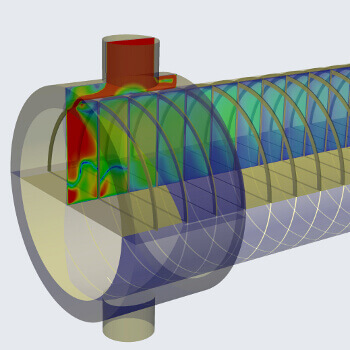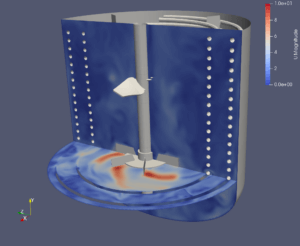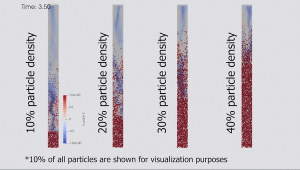Phone: +31 (0)85 058 0046
E-mail: infoaanvraag@dynaflow.com
E-mail: infoaanvraag@dynaflow.com
ABOUT US
HEAD OFFICE
Laan van Oversteen 20
6th floor
2289 CX Rijswijk
The Netherlands
To understand intricate flow phenomena within complex and sensitive systems, the required level of detail requires the analysis to go beyond a one-dimensional analysis, and instead, the complete 3-dimensional flow field needs to be resolved within the component. Through an understanding of the 3-dimensional flow and thermal fields, design changes and strategies to improve the component can be evaluated.
Using Computational Fluid Dynamics (CFD), accurate predictions can be made concerning this 3-dimensional flow field, thereby improving a system’s efficiency, reliability, safety, and performance. CFD, in which the governing equations of fluid flow are solved numerically, can be used to predict the flow properties at every stage of a process. In this way, the influence of various fluid dynamic effects can be captured, including flow transition, flow separation, and vortex shedding. It is a highly cost-effective tool to enable designers to decipher flow fields and evaluate the impact of their design choices. CFD offers the designers of pumps, compressors, mixers, equipment, and other flow components, the opportunity to reduce their development costs.
A CFD study, given the approximations in the analysis, is not a straightforward undertaking. Apart from the advantages of performing detailed flow analysis, CFD calculations also provide vital information regarding the fluid forces acting on the system. This way, flow-induced vibrations can be detected and resolved. Furthermore, CFD allows corrosion rates at specific locations to be predicted.
CFD projects at DRG range from pressure drop calculations in a pipeline to determining the general flow behavior within a multiphase industrial separator. Typically, CFD is used to examine the performance of specific components, it can be used to optimize the design of equipment (i.e. heat exchangers, mixers, separators) or to tailor the design of an orifice plate to meet the process requirements. Our experts have years of CFD experience in various fields and are capable of delivering robust solutions that meet and exceed industry standards.

The intricate nature of three-dimensional flow can be captured using CFD and assessed with the extensive experience of DRG.

CFD is a powerful tool that can be used to optimize designs and help improve performance, efficiency, reliability, and cost.

With CFD a detailed overview of the entire volume of interest can be obtained, instead of a few probed locations of an experimental setup.
Heat exchangers play a crucial role in facilitating the transfer of thermal energy between fluids at different temperatures, finding widespread applications across various industries. Dynaflow specializes in offering comprehensive mechanical, thermal, and flow analyses for heat exchangers, leveraging cutting-edge technologies and adhering to the latest industry standards. As the heat transfer and temperature field in heat exchangers depend strongly on the fluid flow through the system, computational fluid dynamic (CFD) analyses may provide crucial information for the design of such systems.

Through the utilization of Computational Fluid Dynamics (CFD), Dynaflow provides realistic insights into the flow patterns within the system. This enables the prediction of heat transfer performance for heat exchangers with arbitrary geometries and under diverse flow conditions, ultimately enhancing their overall efficiency. Notably, CFD analyses are particularly advantageous in evaluating non-uniform flow and unconventional geometries.
Moreover, detailed flow information can be used to determine the magnitude and location of pressure drops in the system. Pressure drops are mainly caused by fluid friction effects and determine the amount of work required to maintain the flow. Knowledge regarding the pressure distribution in the heat exchanger therefore helps to improve the efficiency of the design.
Special techniques have been devised to make CFD studies feasible for tubular heat exchangers with a large amount of tubes.
These techniques consist of the definition of an equivalent volume filled with a porous medium, which replaces the complex geometry of a tube bundle. The applicable flow equations are modified such as to account for the pressure loss and thermal exchange. Such flow analyses are relatively easy and fast to perform while yielding accurate results regarding pressure losses and thermal transfer. They can also be used as an optimization tool.
Beyond understanding the fluid behavior, CFD calculations also yield crucial information about the fluid forces acting on the system. There are instances where relying solely on CFD analysis may be insufficient for design approval or identifying the root cause of a failure. In such cases, Dynaflow Research Group recognizes the importance of incorporating structural analysis as an integral part of the overall assessment.
As a multi-disciplinary engineering company, Dynaflow Research Group excels in seamlessly integrating the outcomes of Computational Fluid Dynamics analyses with comprehensive structural analyses. This holistic approach ensures a thorough evaluation of heat exchangers, addressing both fluid dynamics and structural considerations for optimal performance and reliability.
Computational Fluid Dynamics (CFD) is also a governing tool to gain insight into the various features crucial for optimizing industrial mixers. One such feature is multiphase flow, a challenging aspect inherent to the three-dimensional nature of the flow in mixers. CFD is needed for the accurate assessment of fluid behavior within systems containing multiple phases, providing valuable data for evaluating mixer performance.

Impeller design is another critical aspect where CFD can play a major role. Through CFD analysis, different impeller designs can be examined, enabling the identification and prevention of dead zones. Additionally, the impact of varying impeller speeds on the mixing process can be precisely evaluated, contributing to the fine-tuning of design parameters.
An often-underestimated facet in mixer design is fluid-structure interaction. Over its design lifespan, mixer components undergo wear and tear, affecting mixer performance. CFD simulations facilitate a detailed analysis of the loads acting on the mixing equipment. This comprehensive assessment includes the consideration of fluid-induced dynamic loads, such as vibrations, as well as the effects of static loads, such as thermal loads. Simultaneously, the eigenfrequency of the structure can be determined to identify and resolve undesirable oscillations, ensuring a robust design.
Our extensive experience includes a diverse range of expertise, spanning different flow regimes, intricate geometries, multiple flow scales, and the handling of non-Newtonian fluids. We are confident in our proficiency to deliver accurate results for any type of multiphase flow problem. We can use CFD as a powerful tool to optimize industrial mixer designs, addressing critical aspects with precision and ensuring superior performance across various operational conditions.
There are many applications where the influence of particles in a flow cannot be neglected, such as dredging, mixing, or food processing. In these cases, the interaction between the particles and the fluid should be modeled to provide accurate results. Dynaflow Research Group has performed both small and large-scale analyses, with the implementation of particles within the flow.

The experience from these projects has led to the development of our particle interaction solver called HADES, which can analyze the particle-fluid interaction of complex shapes and different particle sizes. With this solver and our experience in particle-fluid interaction analyses, we are able to provide an accurate representation of your system and help to find the solution to your specific problem.

CFD analyses are done with HELYX OpenFOAM: a general-purpose CFD software package, based on an advanced open-source simulation engine developed by ENGYS using OpenFOAM technology. The CFD simulation engine, HELYX features an advanced hex-dominant automatic mesh algorithm with polyhydra support which can run in parallel to generate large computational grids.
Laan van Oversteen 20
6th floor
2289 CX Rijswijk
The Netherlands
© Dynaflow Research Group BV